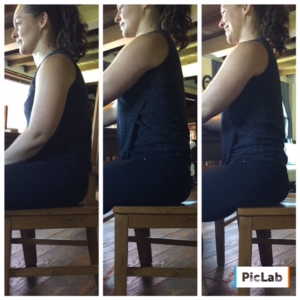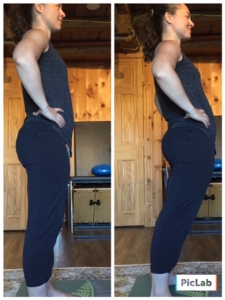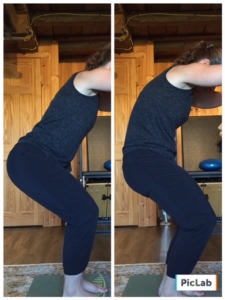When talking about fitness and posture, you’ll often hear people refer to a neutral spine, but finding neutral can be harder than it seems for a natural position our body is supposedly supposed to have. Most often in fitness when instructors say neutral they are referring to the low back and pelvis, but all our joints have a neutral position. Experimenting with where your neutral is in the low back and pelvis is usually the easiest place to start. So let’s experiment with finding neutral in different positions.
Neutral Lying Down
The easiest way to find neutral is to lie down on the floor with knees bent, feet on the floor. This is the easiest position to find neutral because you can actually feel the floor (or not feel it). When you press the lower back toward the floor, known as imprinting, you can usually feel the floor touching your lower back. Conversely, or neutral you should have a slight arch in the lower back. There should be some space between your spine and the floor. There doesn’t have to be a lot of space and everyone’s neutral can be different. Generally, the rule is that you should be able to fit one or two fingers between your back and the floor in neutral. But create more and less space. Notice where you feel the most comfortable. Check for any sense of strain. Try to feel out what your neutral feels like.
When you rock from neutral to imprint the motion should feel like it comes from the abdominals–not the butt, back or legs. This is not a huge movement. Make it large and chances are other parts of the body are getting involved.
https://www.youtube.com/watch?v=Wc6_IdfiPuo
I’m not knocking instructors here. I am one. But I’ve trained with people who told me my neutral was way beyond my neutral, creating a really large arch in my back. Have a dialogue with any instructor if something doesn’t feel right to you. Any instructor worth their certification will want to know what you feel and talk to you about it. What looks neutral to someone’s eye is helpful, but not guaranteed to be accurate. You need to learn what you feel in your body. And neutral should not feel like a place you have to strain to be. It might feel different then you are used to, but not bad.
Neutral Sitting Down

Left: I’m slumped like I probably sit a lot throughout the day. Middle: I’m trying to sit neutral. Right: To actually get neutral I have to move forward on the chair or my legs are in the way of me getting in my neutral position.
Next you can try finding neutral while sitting. If you are sitting on the floor with your legs straight out, finding neutral is probably impossible for most people. It will probably be easier to sit in a chair or at least sit slightly elevated. If you’ve ever taken a yoga class, the instructor probably referred to your sitz bones. Those are the bones on either side of your butt. To sit neutral you need to be on top of them. When we sit most of us, even in a chair with our legs bent and feet on the floor, will tuck under and rock back onto a more fleshy part of our butt. Sitting on the floor will exacerbate this even further. The average person is probably not going to risk rocking beyond neutral and creating too large of an arch in the back when sitting, though it can happen. Check to see if you are sitting right on top of those boney protrusions in your butt.
Neutral Standing
When standing you can’t feel the floor beneath your back or the seat beneath your sitz bones, so it gets hard to sense yourself in space. You can tilt the pelvis under or stick it out, but you can also push it forward in space or back in space. This is where it’s time to start playing a game and checking in with your own body. I often check-in to see my alignment when I’m standing in line or pumping gas. Start by accessing where your weight is. Do you have more weight over your toes or in your heels? If you look sideways in a mirror is your pelvis pushed forward or back? Generally, although we are all a little different, you pelvis should be over your heels and over your knees. Then your shoulders should be stacked over your pelvis. Look in a mirror and experiment. Then try to find that position without the mirror. It can feel different every day.
Neutral Moving—Like a Squatting or Walking
Our body can move in so many ways. The pelvis and spine should not stay neutral through all of them. It’s able to move, round, arch, twist and we want to maintain all those types of movement. That being said when you exercise it’s important to ensure the back is safe, so if your pelvis is supposed to be neutral, it’s important to learn what that feels like. Starting with standing is helpful. Then consider neutral in other types of movement.
Think of a squat. Often when people do a squat they tuck their tailbone between their legs as they bend their knees, but the pelvis should remain neutral. So even when you are doing a big range, full body motion, it’s beneficial to consider what your pelvis is doing and how it’s moving. Ask, how is this large movement affecting my back?
When you walk if you have a tendency to tuck the tailbone under, you may reduce the range of motion in your leg and how your glutes (or butt) can fire to propel you forward. In the United States, many people have a pelvis that is tucked under and a lower back without it’s natural curve. So when in doubt stick it out.
I’ve read articles that state that fitness professions and physical therapists put too much emphasis on posture and alignment. The reality is everyone’s body is different. I’ve worked with people that don’t feel comfortable in what looks like neutral for their body or don’t find relief in what appear to be neutral positions. That’s why it’s important to tell any practitioner you are working with what you feel. We may be experts in our field, but you are the best expert in your body. And no human is made in perfect symmetry, which certainly throws a wrench in the perfect posture game. That being said, it’s not about perfection. It’s about what feels good and finds you relief. It’s about having some control of how your body moves in space. The more you can experiment with your body, the more comfortable you will be in your body. Your neutral may be different than your neighbor’s neutral. Each day the body is a puzzle we have to figure out and experiment with. Play with yours.
Want more Personal Euphoria?
Follow the Personal Euphoria Facebook page, follow Personal Euphoria on Instagram, and subscribe to the Personal Euphoria YouTube Channel.


